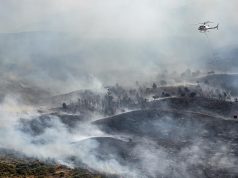Higher risks for incident asthma consistently linked with joint exposure using the environment risk score combining three domains
By Elana Gotkine HealthDay Reporter
WEDNESDAY, May 28, 2025 (HealthDay News) — Air pollution, built environment, and ambient temperature jointly contribute to incident asthma risk, according to a study published online May 15 in The Lancet Regional Health: Europe.
Zhebin Yu, Ph.D., from the Karolinska Institutet in Stockholm, and colleagues analyzed data from 14 European cohorts to examine the impact of the urban exposome on asthma incidence. Three external exposome domains (air pollution, built environment, and ambient temperature) were linked to participants’ home addresses at baseline.
The researchers identified 7,428 incident asthma cases among 349,037 participants from birth to age 70 years or older. The risks for asthma were higher for clusters characterized by high particulate matter and nitrogen dioxide exposure in adults (odds ratio, 1.13) and for clusters characterized by high built-up area and low levels of greenness in children and adults (odds ratios, 1.36 and 1.15 for birth cohorts and adult cohorts, respectively). Higher risks for incident asthma were consistently associated with the joint exposure using the environment risk score combining the three domains (odds ratio, 1.13 for birth cohorts; odds ratio, 1.15 for adult cohorts per 20 percent increase). Of the incident asthma cases, 11.6 percent could be attributed to an environmental risk score above cohort-specific median levels.
“We found that the joint exposure to multiple hazardous urban environmental factors, including air pollution, lack of greenness, and higher built-up areas, was consistently associated with a higher risk of incident asthma across the cohorts,” the authors write.
One author disclosed ties to the pharmaceutical industry.
Copyright © 2025 HealthDay. All rights reserved.








